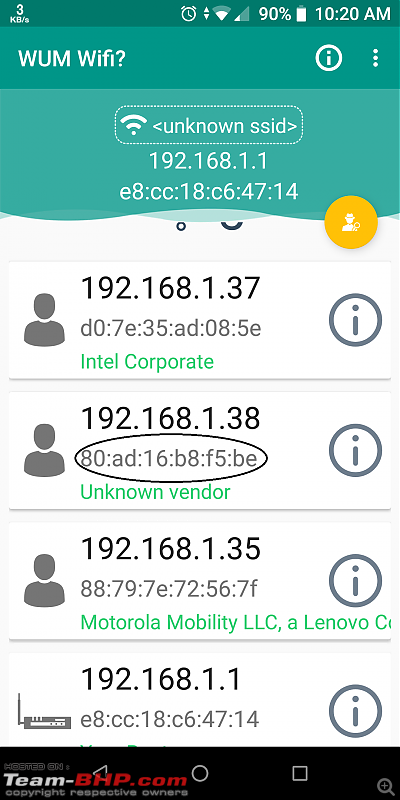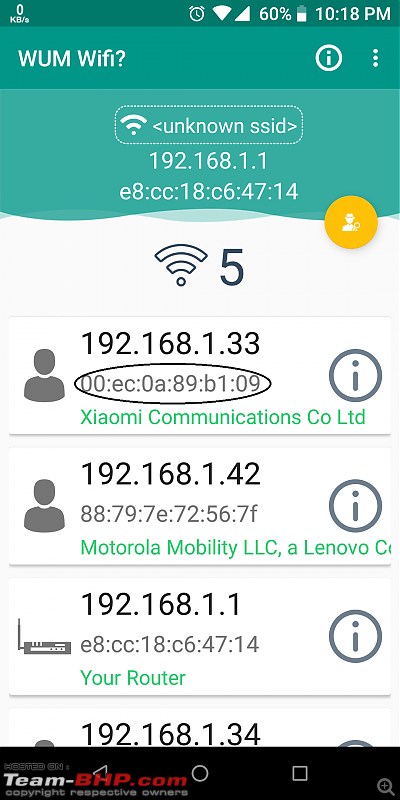
 | |
|
Originally Posted by ani_meher
(Post 4430151)
I have TP WE 855 RE range extender, which I use for extending Jio wifi's range. Due to suspicion of hacking, I have enabled Mac address filtering on JioFi, so that only allowed devices can connect. I have added this extender's Mac address to white list of JioFi. But somehow it doesn't connect to internet by this method. When the filtering is disabled, it works perfectly. But stops working as soon as mac filtering is enabled. I am entering the mac address of the extender properly. What is going wrong? Any pointers? |
|
Originally Posted by ani_meher
(Post 4430151)
I have TP WE 855 RE range extender [...] I have enabled Mac address filtering on JioFi [...] I have added this extender's Mac address to white list of JioFi. But somehow it doesn't connect to internet by this method. |
|
Originally Posted by raghu.t.k
(Post 4430139)
Thanks for the quick response. Will take a look at this. I was looking for a dedicated router something like the SRX5308 – ProSAFE Quad WAN Gigabit SSL VPN Firewall ( dont know how much it would cost) but is already EOL. Let me do some more googling. |
| In your current setup, do you face any issues with banking/online stores sites where the session needs to be maintained across the pages? |
|
Originally Posted by binand
(Post 4430174)
Add the mac addresses of all the laptops/phones etc. in the Jio device. Depending on your configuration, you might need the extender's mac in the Jio device as well. |
|
Originally Posted by drivingme.crazy
(Post 4430171)
And good luck with the Spanish translation. :D |
| I had a similar problem, I need to use the TL-W855RE extender with a main router (host) with activated MAC filter. The problem is the MAC addresses, here my case: MAC of the tplink device: 70: 4F: 57: D2: 3F: 2C SSID MAC tplink: 70: 4F: 57: D2: 3F: 2D It is necessary to disable the MAC filter on the host, to identify the MAC address that actually arrives at the host, and in my case I found the following: 72: 4F: 56: D2: 3F: 2C Now the strangest thing, if I enable the MAC filter again, after configuring it with the address 72: 4F: 56: D2: 3F: 2C included, the repeater is not connected. I found that there is another address that needs to be included, and that it does not appear anywhere, I just guessed it, and it was: 72: 4F: 56: D2: 3F: 2D that is, the following address to which I really identified before 72: 4F: 56: D2: 3F: 2C) Then, including in the MAC filter the two addresses 72: 4F: 56: D2: 3F: 2C and 72: 4F: 56: D2: 3F: 2D) the extender connects to the host. The programming of this tplink extender is very rare. In addition, to add new devices that will connect to the tplink, it is necessary to include a combined MAC address in the host, the first three values correspond to the MAC address of tolink and the other three values to the last values of the MAC of the device, example : MAC tplink: 72: 4F: 56: D2: 3F: 2C MAC laptop: 9C: AD: 97: 39: 6C: F9 Then the address 72: 4F: 56: 39: 6C: F9 must be included in the main router (host). It's very weird this, but it seems that way it works. |
|
Originally Posted by blackwasp
(Post 4429331)
Having a weird problem... Now, my suspect is the power socket, but is there any possibility of ethernet cables causing this? |
|
Originally Posted by R2D2
(Post 4429979)
802.11 AC is backward compatible with previous 802.11 standards. Only thing I'd suggest is using an AC router for best performance and experience. |
|
Originally Posted by rohan_iitr
(Post 4430405)
Thanks for the confirmation. :thumbs up My existing router (provided by Airtel) does not support 802.11ac. It supports n, but I use it at g because my ancient laptop does not have n support. Let me try using the Chromecast with the existing setup, I feel it may be able to support 720p streaming video. :) Rohan |
|
Originally Posted by drivingme.crazy
(Post 4430171)
This might help. https://forum.tp-link.com/showthread...bled-on-router And good luck with the Spanish translation. :D |
|
Originally Posted by ani_meher
(Post 4430646)
This worked! The mac address printed on body of extender is not needed to be added to white list. It is off by one letter. Only the actual mac as shown on extender page, mac shown on JioFi connectionpage, and a derivative mac using the relationship of printed mac and extender page mac is needed. Very complicated! But finally I can use the extender with the JioFi. Thanks a lot! |


|
Originally Posted by sagarpadaki
(Post 4456504)
Over the past few months, I was observing that the QoS that I was getting on the devices in my house used to vary a lot. We have a 10MBPS connection from BSNL at home. The router is a DLink 2750U ADSL WIFI router. I was getting a huge variance in download and streaming speeds even with 10 MBPS line.I complained to BSNL and they said everything is fine on their end.. |
|
Originally Posted by sagarpadaki
(Post 4456504)
Even then some other person was able to crack it and use the network. |
|
Originally Posted by sagarpadaki
(Post 4456504)
The circled MAC is the unidentified one. Please help |
|
Originally Posted by Ashutosh
(Post 4456525)
I had a similar issue recently, I took the following steps: 1- Downloaded an offline password generator 2- Created a new SSID with the generator. 3- Created a new 'strong' password for that SSID similarly. 4- Deleted the old SSID. 5- Verified Wifi is running on WPA2+AES or higher security option 6- Implemented the new SSID. 5- Hid the new SSID broadcast. (Hidden Network) 6- Specified which MAC addresses can connect. (Using MAC Filter/AcessControlList) 7- Reduced the range of Wifi (Signal Strength) to 25%. 8- Saved settings and restarted the Wifi. WARNING ⚠️ Steps 5 & 6 are only for a couple of days/ weeks and is meant for a short deterrent. As it's easily hackable and dangerous in cases. Hopefully this will solve the issue. |
|
Originally Posted by binand
(Post 4456531)
Two questions. 1. How much do you trust this app to tell you the "right" thing? 2. What is the Wifi security settings that you use? You need to check this in your router. |
|
Originally Posted by R2D2
(Post 4456532)
Your router may be compromised. Download the firmware from D Link and re-flash the router firmware. Then reset it using the button at the back or bottom of the case to erase all settings and set it up from scratch. The reset is a MUST. Use a complex administrator (log in) password and ditto for the wi-fi password. Make sure you use on "WPA2 personal" encryption for the wi-fi. WPA2 has been superseded by WPA3 but that's a different topic. |
|
Originally Posted by sagarpadaki
(Post 4456504)
Over the past few months, I was observing that the QoS that I was getting on the devices in my house used to vary a lot. We have a 10MBPS connection from BSNL at home. The router is a DLink 2750U ADSL WIFI router. I was getting a huge variance in download and streaming speeds even with 10 MBPS line.I complained to BSNL and they said everything is fine on their end. I happened to download this app 'WUM Wifi' on my android which claimed that it will list down all the connected devices to a wifi network. I was shocked to see that in addition to the known MAC address of our house devices, a Xiaomi device and an Unknown device were connected. I immediately changed the Wifi password to a pretty complex one and ran the app again. All looked good for a day. The next day I again see this Xiaomi device connected. The password was a complex 20 character one with all the googlies thrown in. Even then some other person was able to crack it and use the network. I have changed the password three times now with increasing complexity and it gets cracked in a day or two. And when the unidentified device is connected, my QoS goes for a toss. Attached are a couple of screenshots. The circled MAC is the unidentified one. Please helpplease: Attachment 1796560 Attachment 1796561 |
| All times are GMT +5.5. The time now is 03:45. | |